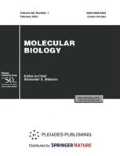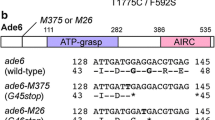Abstract
It is known that the efficiency of nonsense suppression in yeasts is controlled both genetically and epigenetically. Since many components of translation machinery are represented by phosphoproteins, the efficiency depends, in particular, on the activity of kinases and phosphatases that include the Ppz1p/Hal3p complex. It contains Ppz1p phosphatase, which is a catalytic subunit, and Hal3p that negatively regulates its function. The aim of this work was to study the mechanisms which relate the activity of Ppz1p/Hal3p complex to nonsense suppression efficiency. In this study, we used a genetic approach implicating the analysis of nonsense suppression phenotype of the strains overexpressing HAL3 or PPZ1 genes and also bearing deletions or mutant alleles of genes, which presumably could participate in the manifestation of these overexpressions. We have shown that Hal3p inhibits not only Ppz1p but also the homologous phosphatase Ppz2p. Our data indicate that Ppz2p is also involved in the control of nonsense suppression efficiency. In the course of search for Ppz1p target protein, it was shown that Ppz1p dephosphorylates at least two proteins involved in translation. Moreover, Ppz1p affects the efficiency of nonsense suppression not only due to its phosphatase activity but also due to another mechanism triggered by its interaction with Hsp70 chaperones.
Similar content being viewed by others
References
Valente L., Kinzy T.G. 2003. Yeast as a sensor of factors affecting the accuracy of protein synthesis. Cell Mol. Life Sci. 60, 2115–2130.
Cox B. 1965. Psi, a cytoplasmic suppressor of super-suppressor in yeast. Heredity. 20, 505–521.
Wickner R.B., Masison D.C., Edskes H.K. 1995. [PSI +] and [URE3 +] as yeast prions. Yeast. 11, 1671–1685.
Galkin A.P., Mironova L.N., Zhuravleva G.A., Inge-Vechtomov S.G. 2006. Yeast prions, mammalian amyloidoses, and the problem of proteomic networks. Genetika. 42, 1558–1570.
Volkov K.V., Aksenova A.Y., Soom M.J., Osipov K.V., Svitin A.V., Kurischko C., Shkundina I.S., Ter-Avanesyan M.D., Inge-Vechtomov S.G., Mironova L.N. 2002. Novel non-Mendelian determinant involved in the control of translation accuracy in Saccharomyces cerevisiae. Genetics. 160, 25–36.
Rogoza O.M., Viktorovskaya O.V., Rodionova S.A., Ivanov M.S., Volkov K.V., Mironova L.N. 2009. Search for genes influencing the maintenance of the [ISP +] prion-like antisuppressor determinant in yeast with the use of an insertion gene library. Mol. Biol. (Moscow). 43, 360–366.
Hinnebusch A.G. 1993. Gene-specific translational control of the yeast GCN4 gene by phosphorylation of eukaryotic initiation factor 2. Mol. Microbiol. 10, 215–223.
Zambrano R., Briones E., Remacha M., Ballesta J.P. 1997. Phosphorylation of the acidic ribosomal P proteins in Saccharomyces cerevisiae: A reappraisal. Biochemistry. 36, 14439–14446.
Wang W., Cajigas I.J., Peltz S.W., Wilkinson M.F., González C.I. 2006. Role for Upf2p phosphorylation in Saccharomyces cerevisiae nonsense-mediated mRNA decay. Mol. Cell. Biol. 26, 3390–3400.
Vincent A., Newnam G., Liebman S.W. 1994. The yeast translational allosuppressor, Sal6: A new member of the PP1-like phosphatase family with a long serinerich N-terminal extension. Genetics. 138, 597–608.
de Nadal E., Fadden R.P., Ruiz A., Haystead T., Ariño J. 2001. A role for the Ppz Ser/Thr protein phosphatases in the regulation of translation elongation factor 1Balpha. J. Biol. Chem. 276, 14829–14834.
Ivanov M.S., Aksenova A.Yu., Burdaeva Ya.V., Radchenko E.A., Mironova L.N. 2008. Overexpression of gene Ppz1 in the yeast Saccharomyces cerevisiae affects the efficiency of nonsense suppression. Genetika. 44, 171–184.
Aksenova A., Muñoz I., Volkov K., Ariño J., Mironova L. 2007. The Hal3-Ppz1 dependent regulation of nonsense suppression efficiency in yeast and its influence on manifestation of the yeast prion-like determinant [ISP +]. Genes Cells. 12, 435–445.
Ter-Avanesyan M.D., Dagkesamanskaya A.R., Kushnirov V.V., Smirnov V.N. 1994. The SUP35 omnipotent suppressor gene is involved in the maintenance of the non-Mendelian determinant [PSI +] in the yeast Saccharomyces cerevisiae. Genetics. 137, 671–676.
Kallmeyer A.K., Keeling K.M., Bedwell D.M. 2006. Eukaryotic release factor 1 phosphorylation by CK2 protein kinase is dynamic but has little effect on the efficiency of translation termination in Saccharomyces cerevisiae. Eukaryot. Cell. 5, 1378–1387.
Gietz R.D., Sugino A. 1988. New yeast-Escherichia coli shuttle vectors constructed with in vitro mutagenized yeast genes lacking six-base pair restriction sites. Gene. 74, 527–534.
Clotet J., Posas F., de Nadal E., Ariño J. 1996. The NH2-terminal extension of protein phosphatase Ppz1 has an essential functional role. J. Biol. Chem. 271, 26349–26355.
Wach A., Brachat A., Pöhlmann R., Philippsen P. 1994. New heterologous modules for classical or PCR-based gene disruptions in Saccharomyces cerevisiae. Yeast. 10, 1793–1808.
Goldstein A.L., McCusker J.H. 1999. Three new dominant drug resistance cassettes for gene disruption in Saccharomyces cerevisiae. Yeast. 15, 1541–1553.
Zakharov I.A., Kozhin S.A., Kozhina T.N., Fedorova I.V. 1984. Sbornik metodov po genetike drozhzhei-sakharomitsetov (Methods of Saccharomyces Yeast Genetics). Leningrad: Nauka.
Sherman F., Fink G.R., Hincks J.B. 1986. Methods in Yeast Genetics. Cold Spring Harbor, NY: Cold Spring Harbor Lab. Press.
Hampsey M. 1997. A review of phenotypes in Saccharomyces cerevisiae. Yeast. 13, 1099–1133.
Sambrook J., Fritsch E.F., Maniatis T. 1989. Molecular Cloning: A Laboratory Manual. Cold Spring Harbor, NY: Cold Spring Harbor Lab. Press.
Kaiser C., Michaelis S., Mitchell A. 1994. Methods in Yeast Genetics. Cold Spring Harbor, NY: Cold Spring Harbor Lab. Press.
Gietz D., St Jean A., Woods R.A., Schiestl R.H. 1992. Improved method for high efficiency transformation of intact yeast cells. Nucleic Acids Res. 20, 1425.
Inoue H., Nojima H., Okayama H. 1990. High efficiency transformation of Escherichia coli with plasmids. Gene. 96, 23–28.
Pont-Kingdon G. 2003. Creation of chimeric junctions, deletions, and insertions by PCR. Methods Mol. Biol. 226, 511–516.
de Nadal E., Clotet J., Posas F., Serrano R., Gomez N., Ariño J. 1998. The yeast halotolerance determinant Hal3p is an inhibitory subunit of the Ppz1p Ser/Thr protein phosphatase. Proc. Natl. Acad. Sci. USA. 95, 7357–7362.
Tarassov K., Messier V., Landry C.R., Radinovic S., Serna Molina M.M., Shames I., Malitskaya Y., Vogel J., Bussey H., Michnick S.W. 2008. An in vivo map of the yeast protein interactome. Science. 320, 1465–1470.
Hiraga K., Suzuki K., Tsuchiya E., Miyakawa T. 1993. Cloning and characterization of the elongation factor EF-1 beta homologue of Saccharomyces cerevisiae. EF-1 beta is essential for growth. FEBS Lett. 316, 165–169.
Venturi G.M., Bloecher A., Williams-Hart T., Tatchell K. 2000. Genetic interactions between Glc7, Ppz1 and Ppz2 in Saccharomyces cerevisiae. Genetics. 155, 69–83.
Bailleul P.A., Newnam G.P., Steenbergen J.N., Chernoff Y.O. 1999. Genetic study of interactions between the cytoskeletal assembly protein Sla1 and prion-forming domain of the release factor Sup35 (eRF3) in Saccharomyces cerevisiae. Genetics. 153, 81–94.
Ariño J. 2002. Novel protein phosphatases in yeast. Eur. J. Biochem. 269, 1072–1077.
Allen K.D., Wegrzyn R.D., Chernova T.A., Müller S., Newnam G.P., Winslett P.A., Wittich K.B., Wilkinson K.D., Chernoff Y.O. 2005. Hsp70 chaperones as modulators of prion life cycle: Novel effects of Ssa and Ssb on the Saccharomyces cerevisiae prion [PSI +]. Genetics. 169, 1227–1242.
Rakwalska M., Rospert S. 2004. The ribosome-bound chaperones RAC and Ssb1/2p are required for accurate translation in Saccharomyces cerevisiae. Mol. Cell. Biol. 24, 9186–9197.
Hatin I., Fabret C., Namy O., Decatur W.A., Rousset J. 2007. Fine-tuning of translation termination efficiency in Saccharomyces cerevisiae involves two factors in close proximity to the exit tunnel of the ribosome. Genetics. 177, 1527–1537.
Author information
Authors and Affiliations
Corresponding author
Additional information
Original Russian Text © M.S. Ivanov, E.A. Radchenko, L.N. Mironova, 2010, published in Molekulyarnaya Biologiya, 2010, Vol. 44, No. 6, pp. 1018–1026.
Rights and permissions
About this article
Cite this article
Ivanov, M.S., Radchenko, E.A. & Mironova, L.N. Protein complex Ppz1p/Hal3p and the efficiency of nonsense suppression in yeasts Saccharomyces cerevisiae . Mol Biol 44, 907–914 (2010). https://doi.org/10.1134/S0026893310060075
Received:
Accepted:
Published:
Issue Date:
DOI: https://doi.org/10.1134/S0026893310060075




